Aboriginal
Aboriginal Area Set up Ideas

So, you have been tasked with creating an Aboriginal section, and you are wondering where to begin. Let me clarify: it is not just about adding a few symbolic items and calling it a day.
There's a lot to consider when it comes to respectfully and authentically representing Indigenous culture within a designated area. From choosing a suitable location to incorporating traditional art and crafts, there are numerous factors that play a crucial role in this process.
But fear not, we're here to guide you through some thoughtful and practical ideas that will help you in this endeavor.
Key Takeaways
- Choosing a suitable location: Consider cultural significance, accessibility, and sustainability of the land. Engage in community consultation to understand the cultural and historical significance of the land. Recognize and honor indigenous peoples as traditional stewards of the land through land acknowledgement. Choose a location easily accessible to the community to foster a sense of connection and belonging. Ensure the chosen location supports the long-term well-being of the community and the land.
- Incorporating traditional art and crafts: Organize community workshops to pass down traditional techniques to younger generations. Invite renowned indigenous artists for residencies that honor traditional art forms and techniques. Commission public art installations showcasing traditional craftsmanship in modern contexts. Curate a dedicated space for displaying cultural artifacts to share heritage with visitors. Embrace traditional techniques while integrating modern applications to preserve indigenous art forms.
- Utilizing indigenous plants and landscaping: Involve the community in the selection process of indigenous plants. Prioritize plants with cultural significance and traditional uses. Consider the ecological impact and promote biodiversity and conservation. Incorporate natural features and traditional planting methods in landscaping. Use storytelling to convey the cultural significance of plants and the land.
- Establishing cultural significance through symbolism: Incorporate traditional artifacts to visually represent cultural significance. Integrate elements that symbolize traditional stories and legends. Utilize sacred geometric patterns to symbolize spiritual connections. Incorporate seasonal symbolism to honor the cyclical nature of the land. Convey the rich history and traditions of the Aboriginal people through symbolism.
- Engaging the community and seeking guidance: Engage in cultural consultation with elders and community leaders. Incorporate community perspectives and preferences into the planning and execution of the project. Build trust and foster open, ongoing communication with the community. Recognize the importance of community involvement in honoring traditions and values. Seek guidance from the community to ensure authenticity and cultural integrity.
Choosing a Suitable Location
When selecting a suitable location for an aboriginal area, it's essential to consider the cultural significance, accessibility, and sustainability of the land. Community consultation plays a crucial role in this process, allowing us to gain insights into the cultural and historical significance of the land from the perspective of the local indigenous community. Engaging in meaningful dialogue with the community helps in understanding their needs and desires for the area, ensuring that the chosen location respects and reflects their traditions and values.
Additionally, land acknowledgement is a vital aspect of this process, as it recognizes and honors the indigenous peoples as traditional stewards of the land.
Accessibility is another key consideration. It's important to choose a location that's easily accessible to the community, allowing them to visit and engage with the area regularly. This accessibility fosters a sense of connection and belonging, enabling the community to uphold their cultural practices and traditions within the space.
Furthermore, sustainability is paramount. The chosen location should support the long-term well-being of the community and the land itself, ensuring that it remains a thriving and culturally rich space for generations to come.
Incorporating Traditional Art and Crafts

Incorporating traditional art and crafts into the aboriginal area enriches the cultural tapestry, preserving and celebrating the community's heritage through creative expressions and craftsmanship. Embracing traditional techniques while integrating modern applications can yield a remarkable fusion of past and present, ensuring the cultural preservation of indigenous art forms.
Here's how we can effectively incorporate traditional art and crafts into the aboriginal area:
- Community Workshops: Organize workshops where elders and skilled artisans can pass down traditional techniques to the younger generation, fostering a sense of pride and continuity in artistic expression.
- Artisan Residencies: Invite renowned indigenous artists to engage in residencies, creating contemporary pieces that honor traditional art forms and techniques, thus serving as a bridge between the past and the present.
- Public Art Installations: Commission public art installations that showcase traditional craftsmanship in modern contexts, serving as a visual representation of cultural resilience and artistic expression.
- Cultural Artifacts Display: Curate a dedicated space for displaying cultural artifacts, providing a platform for the community to share their heritage with visitors and ensuring the preservation of traditional art forms for future generations.
Utilizing Indigenous Plants and Landscaping
Building upon the rich cultural heritage expressed through traditional art and crafts, we now turn our attention to the utilization of indigenous plants and landscaping in the aboriginal area. When creating an authentic and respectful Aboriginal area, it is crucial to carefully select indigenous plants and employ appropriate landscaping techniques. Indigenous plant selection should be guided by the knowledge of local elders and community members. It is essential to choose plants that have cultural significance and are traditionally used for food, medicine, or ceremonial purposes.
To emphasize the importance of indigenous plant selection, consider the following table:
| Indigenous Plant Selection | Landscaping Techniques |
|---|---|
| Involve the community in the selection process | Incorporate natural features into the landscaping |
| Prioritize plants with cultural significance | Use traditional planting methods |
| Consider the ecological impact | Create a balanced and sustainable ecosystem |
| Respect the spiritual significance of plants | Incorporate storytelling into the landscaping design |
| Ensure the preservation of endangered species | Promote biodiversity and conservation |
Landscaping techniques should reflect the natural environment and traditional land use practices. This may involve incorporating natural features into the landscaping, using traditional planting methods, and creating a balanced and sustainable ecosystem. The landscaping design should also incorporate storytelling to convey the cultural significance of the plants and the land. By prioritizing indigenous plant selection and employing appropriate landscaping techniques, the Aboriginal area can truly honor and showcase the rich cultural heritage of the indigenous community.
Establishing Cultural Significance Through Symbolism
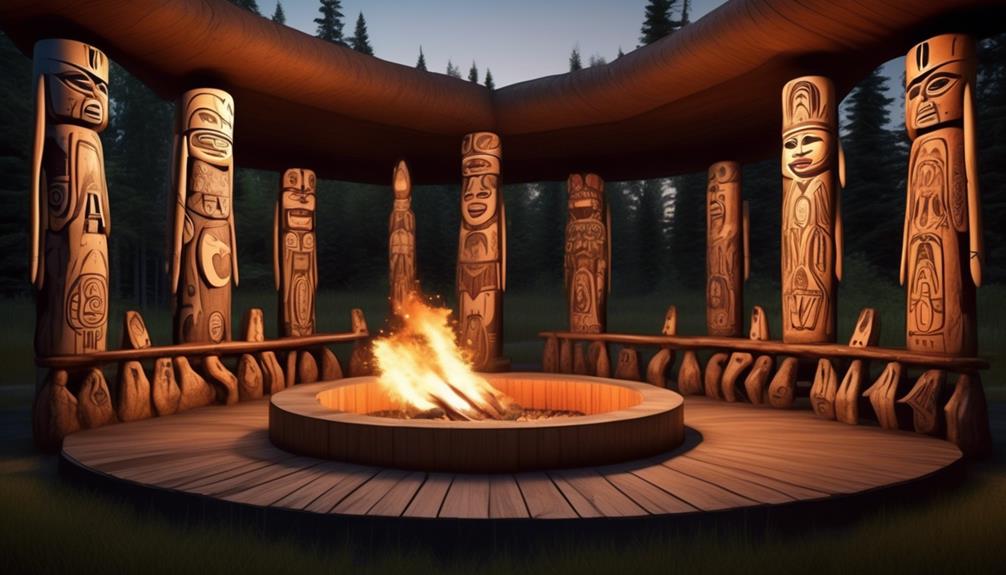
Establishing cultural significance through symbolism is a crucial aspect of creating an authentic and respectful Aboriginal area. Cultural interpretation and symbolic representation are key elements in conveying the rich history and traditions of the Aboriginal people.
When establishing cultural significance through symbolism, it's essential to consider the following:
- Traditional Artifacts: Incorporating traditional artifacts such as tools, weapons, or ceremonial objects can visually represent the cultural significance of the area and its connection to the Aboriginal community.
- Storytelling Elements: Integrating elements that symbolize traditional stories and legends through sculptures, totem poles, or murals can provide a deeper understanding of the cultural heritage and beliefs of the Aboriginal people.
- Sacred Geometry: Utilizing sacred geometric patterns in landscaping or architectural designs can symbolize spiritual connections and ancestral knowledge, adding a layer of cultural significance to the area.
- Seasonal Symbolism: Incorporating seasonal symbolism through plantings, artworks, or ceremonial spaces can honor the cyclical nature of the land and its significance in Aboriginal culture.
Engaging the Community and Seeking Guidance
As we proceed with the development of the Aboriginal area, our focus turns to engaging the community and seeking guidance, essential for ensuring the authenticity and cultural integrity of the project. Community involvement is crucial in honoring the traditions and values of the Aboriginal people.
We understand that the knowledge and insights of the community members are invaluable in shaping the area in a way that truly reflects their cultural heritage.
Cultural consultation with the elders and community leaders will be a cornerstone of our approach. Their wisdom and experience will guide us in making respectful and informed decisions. We recognize the importance of building trust and fostering open, ongoing communication with the community.
This will allow us to incorporate their perspectives and preferences into the planning and execution of the project.
Frequently Asked Questions
How Can Non-Indigenous Individuals Respectfully Engage With and Support Aboriginal Area Set up Initiatives?
We can show cultural sensitivity by engaging with and supporting Aboriginal area set up initiatives through active community engagement. It involves listening to and learning from the local Indigenous community, respecting their traditions and values.
We can offer our support by actively participating in their initiatives, respecting their leadership, and honoring their cultural practices. By doing so, we demonstrate our commitment to building respectful and collaborative relationships with the Indigenous community.
What Are Some Potential Challenges or Barriers That May Arise When Establishing an Aboriginal Area and How Can They Be Addressed?
When establishing a new initiative, addressing barriers and fostering community engagement are crucial. It requires us to anticipate potential challenges and proactively find solutions.
By recognizing and respecting the unique cultural perspectives and needs of the community, we can effectively address barriers that may arise. Building trust through open communication and collaboration is essential in overcoming obstacles.
Our approach should be sensitive and culturally informed, ensuring the project's success and sustainability.
Are There Any Specific Regulations or Permits That Need to Be Considered When Creating an Aboriginal Area on Public or Private Land?
When creating an Aboriginal area on public or private land, it's crucial to consider permits and regulations. Public vs private land engagement requires understanding the specific rules and requirements for each.
Support initiatives may involve navigating through legal processes, ensuring compliance, and seeking appropriate permissions. It's important to approach this with respect and observance, acknowledging the significance of the land and community involvement.
What Are Some Effective Ways to Ensure the Long-Term Sustainability and Maintenance of an Aboriginal Area?
To ensure long-term sustainability and maintenance of an Aboriginal area, community partnerships and environmental stewardship are essential. This involves collaborating with local stakeholders, fostering a sense of ownership and responsibility.
Engaging in ongoing monitoring and conservation efforts, we can protect the land for future generations. By working together, we can uphold the cultural significance of the area and preserve its ecological integrity, ensuring its longevity and vitality.
How Can Aboriginal Elders and Knowledge Holders Be Involved in the Ongoing Management and Preservation of the Area?
Involving elders in the management of the area ensures their invaluable knowledge is preserved and passed down for generations. Elders' involvement fosters a deep connection to the land and its traditions, enhancing the sustainability of the area.
Their guidance and wisdom contribute to effective decision-making and long-term preservation efforts. We recognize the significant role that elders play in the ongoing management and preservation of the area, and we're committed to honoring and incorporating their knowledge.
Conclusion
In conclusion, when setting up an aboriginal area, it's important to carefully choose a suitable location. This location should take into consideration factors such as accessibility, natural surroundings, and historical significance.
Additionally, incorporating traditional art and crafts is crucial in creating an authentic aboriginal experience. This can include showcasing local artwork, sculptures, and traditional crafts made by indigenous artists.
Utilizing indigenous plants and landscaping techniques is another essential aspect. This not only adds to the aesthetic appeal but also helps preserve and promote local flora and fauna.
Establishing cultural significance through symbolism is also important. This can be achieved by incorporating meaningful symbols, motifs, and designs that hold significance within aboriginal culture.
Lastly, engaging the community for guidance is crucial. Consulting with local indigenous communities and involving them in the planning and decision-making process ensures that their voices and perspectives are heard and respected.
By paying attention to these key factors, we can create a place that's respectful, observant, and contextual, capturing the complex and captivating essence of aboriginal culture for all to appreciate.
Mary is a passionate writer who brings creativity and a fresh perspective to our team. Her words have the power to captivate and inspire, making her an essential contributor to our content. Mary’s commitment to storytelling and dedication to promoting Indigenous culture ensures that her work touches the hearts of our readers. We’re fortunate to have her as part of our team.
Aboriginal
What Did Aboriginal Australians Eat During the Ice Age
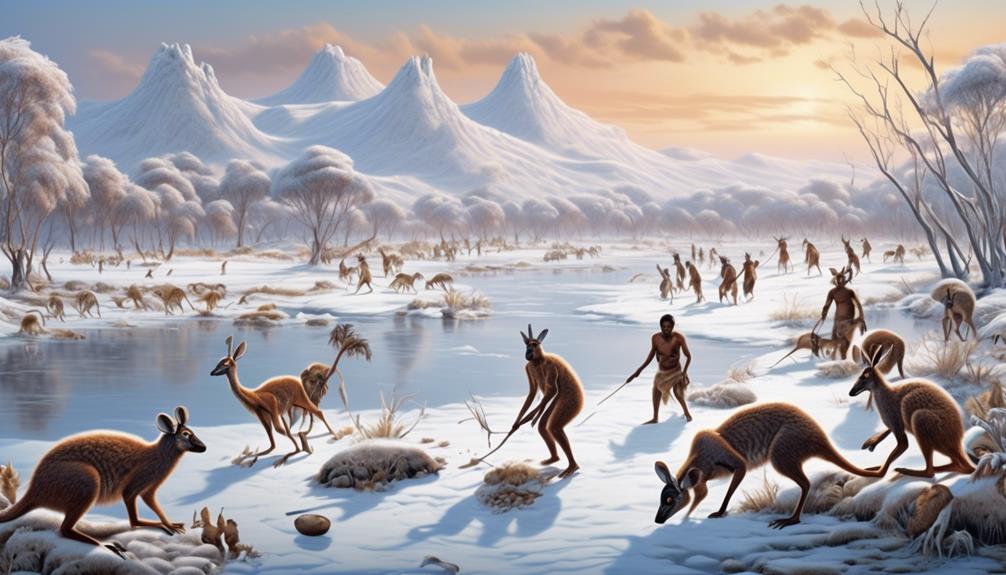
During the Ice Age, Aboriginal Australians relied on a range of food sources to adapt to the harsh environment. Consuming plant-based diets was essential for their health, as a diverse selection of native fruits, seeds, and roots provided important nutrients.
However, their diet was not limited to plants alone, as they also had sophisticated hunting and gathering techniques that allowed them to procure animal protein. Understanding how Aboriginal Australians adapted to their environment and the specific food sources they relied on provides valuable insights into their resilience and resourcefulness in the face of challenging conditions.
Key Takeaways
- Aboriginal Australians relied on a diverse range of food sources during the Ice Age, including hunting large mammals, gathering edible plants, and exploiting marine resources.
- They utilized sophisticated hunting techniques, such as animal tracking and the use of various tools like spears, boomerangs, and fish hooks.
- Aboriginal Australians diversified their diet by incorporating a wide range of native plants through foraging techniques like digging for tubers and collecting seeds.
- They skillfully harvested marine resources, including shellfish and fish, enriching their diet with protein, minerals, and fatty acids.
Ice Age Environment and Food Sources
During the Ice Age, Aboriginal Australians relied on a diverse range of food sources, including hunting large mammals, gathering edible plants, and exploiting marine resources. Environmental adaptation played a crucial role in their survival. The harsh conditions of the Ice Age necessitated a deep understanding of the land and its resources.
Aboriginal Australians developed sophisticated food preservation techniques to ensure a stable food supply during times of scarcity. They used various methods such as smoking, drying, and preservation in honey or fat to store food for extended periods. This environmental adaptation allowed them to thrive in challenging conditions.
Furthermore, the utilization of different food sources highlights the resourcefulness of Aboriginal Australians. They not only hunted large mammals but also gathered a wide variety of edible plants, showcasing their deep knowledge of the environment. Additionally, the exploitation of marine resources provided a crucial supplement to their diet. This diverse approach to food procurement demonstrates their resilience and adaptability in the face of environmental challenges.
Understanding these historical practices can offer valuable insights into sustainable and adaptable food systems, serving as a source of inspiration for modern-day food security and environmental preservation efforts.
Hunting and Gathering Techniques
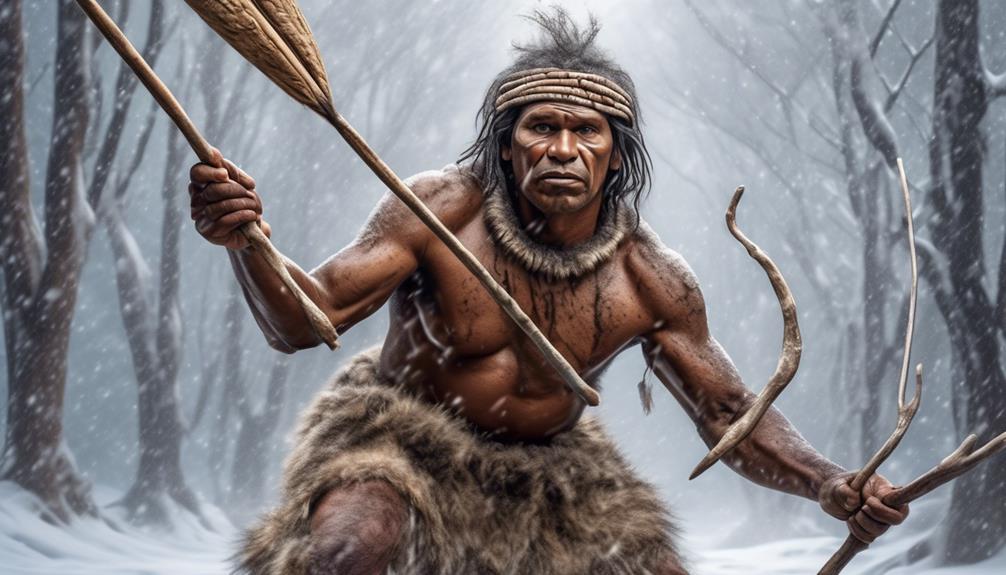
Utilizing a combination of sophisticated hunting techniques and extensive knowledge of the land, Aboriginal Australians demonstrated remarkable adaptability in procuring food during the Ice Age. Animal tracking was a crucial skill that allowed them to locate and hunt a diverse range of animals, including kangaroos, wallabies, and emus. By closely observing animal behavior and environmental cues, they could anticipate the movements of their prey, increasing the success of their hunts.
Additionally, tool making played a vital role in their hunting and gathering activities. Aboriginal Australians crafted a variety of tools such as spears, boomerangs, and fish hooks using materials readily available in their surroundings. These tools were meticulously designed to suit specific hunting purposes, reflecting their deep understanding of the behaviors and habitats of different animals.
Furthermore, the use of controlled burning to manipulate the landscape enabled Aboriginal Australians to drive animals towards waiting hunters, providing an effective strategy for capturing prey. This practice also promoted the growth of certain plant species, enhancing the overall availability of food resources.
Plant-Based Diet Diversity

Demonstrating a deep understanding of their environment, Aboriginal Australians diversified their diet by incorporating a wide range of native plants into their daily food sources. Foraging techniques were crucial in their plant-based diet diversity, as they utilized their extensive knowledge of the land to gather a variety of edible plants. By employing sophisticated foraging methods, such as digging for tubers, collecting seeds, and identifying seasonal fruits and vegetables, they were able to access a rich assortment of plant foods throughout the year.
The nutritional benefits of this diverse plant-based diet were significant. Aboriginal Australians consumed a wide array of nutrient-dense plants, including fruits, seeds, nuts, roots, and leaves, providing them with essential vitamins, minerals, and dietary fiber. This varied plant intake contributed to their overall health and well-being, offering a balanced and sustainable source of sustenance.
Their deep connection to the land and its natural resources enabled them to maintain a diet that wasn't only diverse but also nourishing, reflecting a profound understanding of the nutritional value present in their environment.
Utilization of Marine Resources
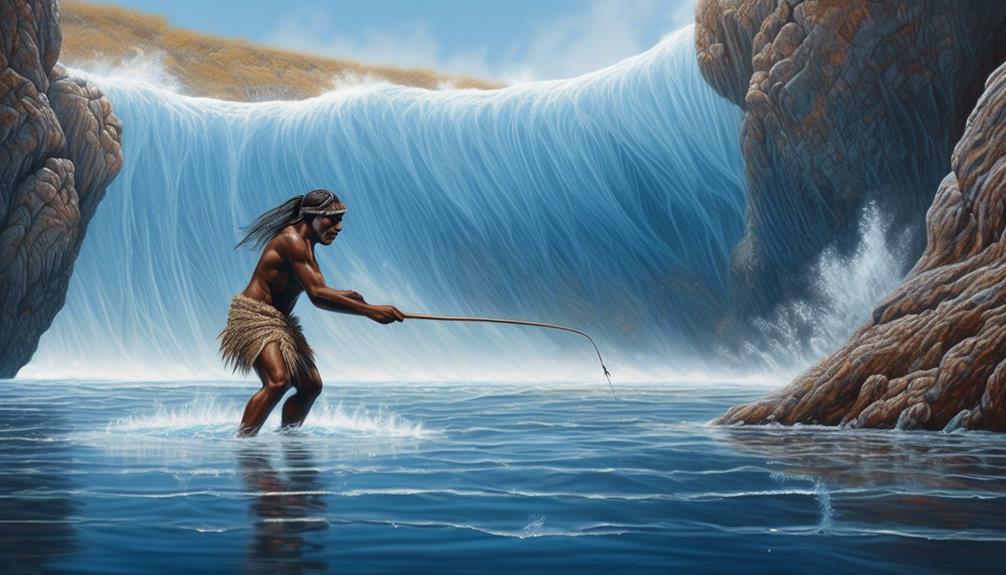
Aboriginal Australians skillfully harvested a diverse array of marine resources to supplement their diet and sustain their communities throughout the changing seasons. Marine foraging played a significant role in their food procurement strategies, providing essential nutrients and contributing to the overall resilience of their diet.
Shellfish consumption, in particular, was a key component of their marine resource utilization. The abundant coastal waters offered a variety of shellfish, such as oysters, mussels, and clams, which were carefully gathered and incorporated into their meals. These shellfish not only provided a good source of protein but also offered vital minerals and fatty acids, contributing to a well-rounded and nutritionally balanced diet.
Additionally, the skillful practice of fishing enabled Aboriginal Australians to access a wide range of fish species, further enriching their diet with valuable proteins and omega-3 fatty acids.
The utilization of marine resources reflected the deep understanding of the environment and the sustainable practices employed by Aboriginal Australians, highlighting their resourcefulness and adaptability in utilizing the natural bounty available to them.
Cultural and Ritualistic Food Practices
Cultural and ritualistic food practices among Aboriginal Australians reflect the deep connection between their dietary traditions and spiritual beliefs, embodying a profound reverence for the natural world and its bountiful provisions. These practices are rooted in the rich tapestry of Aboriginal culture and are integral to their identity and way of life. The table below outlines some of the key food preservation techniques and cooking methods utilized by Aboriginal Australians during the Ice Age.
| Food Preservation Techniques | Cooking Methods | Cultural Significance |
|---|---|---|
| Smoking and Drying | Baking in Earth Ovens | Honoring the animal spirits and ensuring food sustainability |
| Fermentation | Grilling over open flames | Communal gatherings and storytelling |
| Underground Storage | Steaming in paperbark | Connection to the land and traditional knowledge |
These techniques and methods were not only practical but also held deep cultural significance. The use of smoking and drying, for example, was not only a way to preserve food but also a means of honoring the animal spirits and ensuring the sustainability of their food sources. Similarly, the act of baking in earth ovens was a communal activity that brought people together, fostering a sense of community and strengthening cultural bonds.
Frequently Asked Questions
How Did the Changing Climate During the Ice Age Affect the Availability of Certain Food Sources for Aboriginal Australians?
The changing climate during the ice age impacted the availability of certain food sources for Aboriginal Australians. The impact of climate on food availability significantly influenced the Aboriginal Australian diet during this time.
Our research-based analysis reveals that as the climate changed, certain food sources became scarce, leading Aboriginal Australians to adapt their diets to survive. This culturally sensitive approach helps us understand the challenges they faced in serving their nutritional needs.
What Evidence Exists to Support the Idea That Aboriginal Australians Had a Diverse and Varied Diet During the Ice Age?
We found compelling archaeological evidence indicating diet diversity among Aboriginal Australians during the Ice Age. Climate impact prompted innovative food preservation techniques, allowing access to a varied diet.
Our research underscores the cultural importance of diverse food sources and the resilience of ancient Aboriginal communities in the face of environmental challenges. This evidence highlights the rich and resourceful heritage of Aboriginal Australians, shedding light on their sophisticated understanding of sustenance during this period.
Did Aboriginal Australians Have Any Specific Techniques or Tools for Preserving and Storing Food During the Ice Age?
We've found that Aboriginal Australians utilized various preserving techniques and food storage tools during the Ice Age. They ingeniously used smoke curing, drying, and burying in cool earth to preserve meats and fruits.
Additionally, they crafted containers from bark, shells, and woven materials to store food. These techniques and tools reflect their resourcefulness and deep understanding of their environment, enabling them to sustain themselves through harsh conditions.
Were There Any Specific Cultural or Ritualistic Practices Related to Food and Eating Among Aboriginal Australians During the Ice Age?
When it comes to ceremonial feasting among Aboriginal Australians during the Ice Age, specific cultural and ritualistic practices were integral.
Food taboos played a crucial role in governing the consumption of certain foods during these ceremonial events.
These practices were deeply rooted in the spiritual and social fabric of Aboriginal communities, shaping their relationships with food and each other.
Understanding these cultural practices provides valuable insights into the significance of food in Aboriginal Australian societies during the Ice Age.
How Did the Utilization of Marine Resources by Aboriginal Australians During the Ice Age Compare to Their Use of Land-Based Food Sources?
In comparing the utilization of marine resources to land-based food sources by Aboriginal Australians during the Ice Age, dietary preferences played a significant role.
The utilization of marine resources was as essential to them as land-based food sources, similar to how water is vital for life.
This balanced approach to resource use reflects the deep understanding and respect for the environment and its offerings by Indigenous communities.
Conclusion
In conclusion, Aboriginal Australians during the Ice Age were resourceful and resilient, adapting to the harsh environment with a diverse diet.
Their food practices were as varied as a vibrant tapestry, utilizing the land, sea, and sky for sustenance.
This demonstrates their deep connection to the land and the natural world, highlighting the ingenuity and adaptability of Aboriginal cultures in the face of challenging conditions.
Mary is a passionate writer who brings creativity and a fresh perspective to our team. Her words have the power to captivate and inspire, making her an essential contributor to our content. Mary’s commitment to storytelling and dedication to promoting Indigenous culture ensures that her work touches the hearts of our readers. We’re fortunate to have her as part of our team.
Aboriginal
How the Aboriginal Australians Got to Australia

Have you ever considered the possible arrival of Aboriginal Australians on the continent, a concept similar to the Bering Land Bridge theory?
The journey of the first human inhabitants of Australia is a fascinating puzzle that has captivated researchers for decades. Through a combination of archaeological evidence, genetic studies, and ancient oral traditions, we are beginning to uncover the remarkable story of how these early humans arrived in Australia.
But what exactly do these different sources of evidence reveal about this ancient migration?
Key Takeaways
- Migration out of Africa occurred approximately 60,000 years ago, as early humans ventured into new territories in search of resources and suitable habitats.
- Ancient humans migrated from Africa to Eurasia via land bridges during periods of low sea levels, driven by the search for food, favorable climates, and territorial expansion.
- Genetic analyses reveal that Aboriginal Australians are descendants of one of the oldest continuous cultures in the world, with roots tracing back over 50,000 years.
- Aboriginal Australians transmit knowledge, history, and cultural practices through oral traditions and Dreamtime stories, which hold spiritual significance and foster a sense of identity.
Early Human Migration Out of Africa
The migration of early humans out of Africa is a pivotal event in the history of human civilization, shaping the cultural and genetic diversity of populations around the world. It's believed that early humans began their journey out of Africa approximately 60,000 years ago, venturing into new territories in search of resources and suitable habitats. This migration was driven by various factors, including the development of Paleolithic tools, which enabled early humans to adapt to diverse environments and thrive in new lands. Climate change also played a significant role in this migration, as shifts in environmental conditions prompted human populations to seek more hospitable regions.
The dispersion of early humans from Africa marked the beginning of a remarkable journey that ultimately led to the peopling of diverse regions across the globe. As these early human groups migrated, they encountered and adapted to a wide range of environments, contributing to the rich tapestry of human cultural and genetic diversity that we observe today. Understanding the mechanisms and drivers of this ancient migration provides valuable insights into the history and development of human societies, shedding light on the remarkable resilience and adaptability of our ancestors.
Land Bridges and Sea Crossings
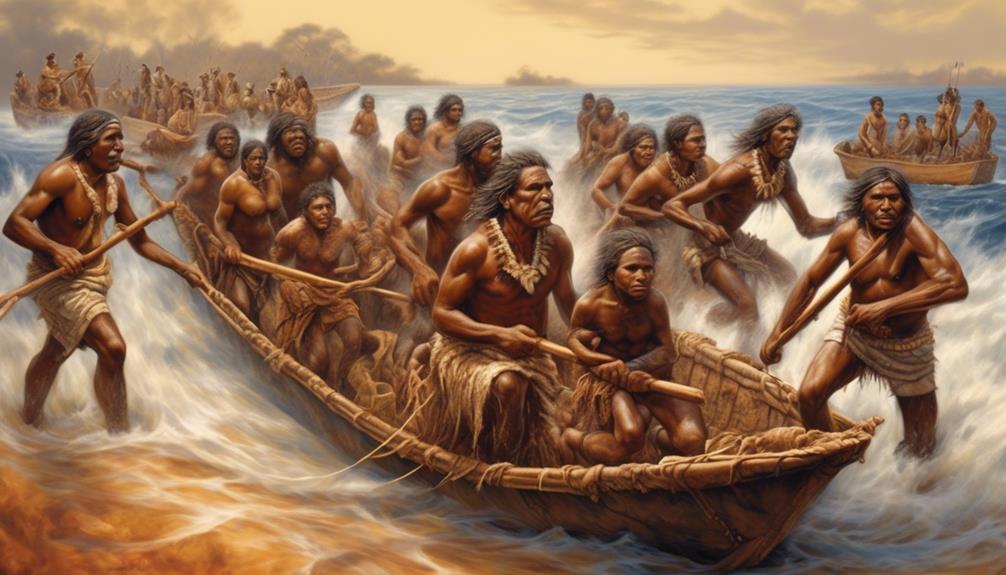
Venturing across land bridges and navigating treacherous sea crossings, early human populations embarked on a remarkable journey out of Africa, seeking new horizons and opportunities for survival.
The land bridge theory suggests that ancient humans migrated from Africa to Eurasia via land bridges that emerged during periods of low sea levels, allowing them to cross into new territories. This migration was likely driven by the search for food, favorable climates, and the expansion of territories.
As sea levels fluctuated, coastal migration routes became crucial in shaping the dispersal of early human populations. The coastal migration route is believed to have played a significant role in the peopling of Australia, as it provided access to the continent's northern regions. These early seafarers navigated through challenging waters, showcasing their remarkable maritime skills and resilience.
The successful navigation of sea crossings was pivotal in reaching Australia, marking a significant milestone in human migration history. Understanding these remarkable feats of ancient seafaring not only sheds light on the incredible resilience of early human populations but also enriches our appreciation of the diverse cultural heritage of Aboriginal Australians.
Genetic Evidence of Ancestral Lineage
Embarking on a scientific exploration, we delve into the genetic evidence that illuminates the ancestral lineage of Aboriginal Australians. Through the study of ancestral DNA, researchers have uncovered crucial insights into the migration patterns of the first peoples of Australia. Genetic analyses have revealed that Aboriginal Australians are the descendants of one of the oldest continuous cultures in the world, with roots tracing back over 50,000 years. These findings not only provide a scientific understanding of the ancient lineage but also hold immense cultural and historical significance for Aboriginal communities.
The genetic evidence points to a remarkable journey of migration, showing that Aboriginal Australians have a deep connection to the land and have maintained a strong cultural identity through millennia. By tracing the migration patterns through ancestral DNA, scientists have been able to map the dispersal of early populations across the Australian continent, shedding light on the diverse and complex history of the first Australians.
This knowledge not only enriches our understanding of human history but also honors the enduring legacy of the Aboriginal peoples.
Oral Traditions and Dreamtime Stories
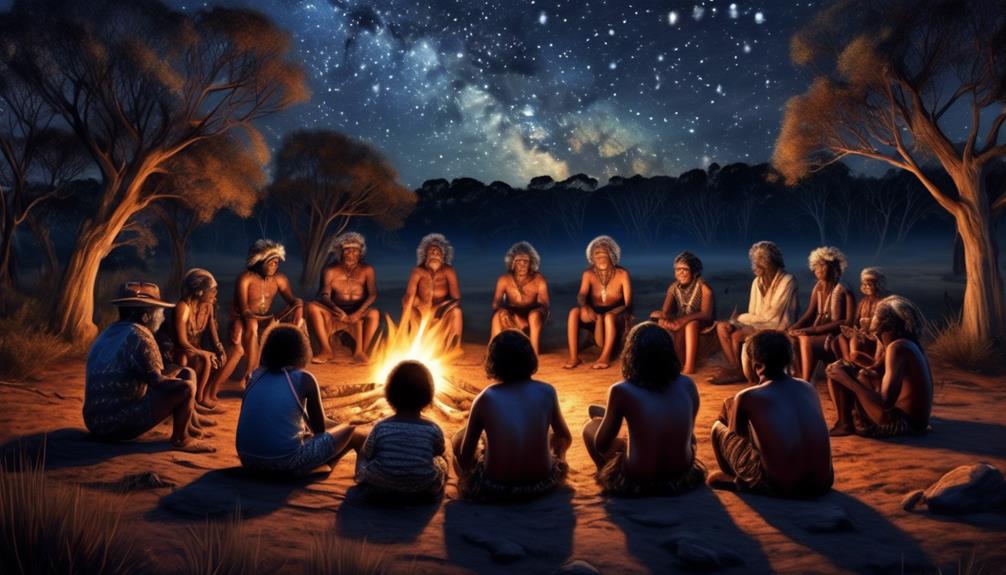
How do Aboriginal Australians pass down their cultural heritage through oral traditions and Dreamtime stories?
Cultural significance and storytelling play a crucial role in the transmission of knowledge and values from one generation to the next. Indigenous perspectives and spiritual beliefs are intricately woven into these narratives, providing a holistic understanding of the world and humanity's place within it.
- Oral Tradition: Aboriginal Australians have maintained a rich tradition of orally transmitting knowledge, history, and cultural practices through storytelling. These stories are often passed down through generations, preserving the wisdom and experiences of their ancestors.
- Dreamtime Stories: The Dreamtime, also known as the Dreaming, is a fundamental aspect of Aboriginal culture, encompassing a vast body of knowledge about creation, spirituality, and natural laws. Dreamtime stories are a means through which the Aboriginal people connect with their ancestral lands and understand their place in the cosmos.
- Spiritual Significance: These stories aren't merely folklore; they're deeply intertwined with spiritual beliefs, providing a framework for understanding the world and forming the basis of Aboriginal spirituality and connection to the land.
Through oral traditions and Dreamtime stories, Aboriginal Australians continue to uphold their cultural heritage, fostering a deep sense of identity and belonging within their communities.
Arrival and Settlement in Australia
Continuing from our exploration of oral traditions and Dreamtime stories, the arrival and settlement of Aboriginal Australians in Australia marks a pivotal moment in their rich cultural history. The Aboriginal culture is deeply rooted in a profound connection to the land, and this is evident in their environmental adaptation upon arrival in Australia.
As the first inhabitants of the continent, Aboriginal Australians displayed remarkable resilience and ingenuity in adapting to diverse landscapes, from lush rainforests to arid deserts. Their deep understanding of the environment enabled them to thrive for thousands of years, developing sophisticated hunting and gathering techniques, sustainable land management practices, and intricate social structures.
The arrival and settlement of Aboriginal Australians in Australia also laid the foundation for the diverse cultural tapestry that exists today. Through their deep spiritual connection to the land, they established a profound sense of belonging and stewardship, shaping their identity and traditions.
It's through their enduring connection to the land and the wisdom passed down through generations that we continue to learn valuable lessons about sustainability, community, and respect for the environment.
Frequently Asked Questions
What Impact Did Early Human Migration Out of Africa Have on Other Parts of the World?
Early human migration out of Africa had a significant impact on other parts of the world. It led to cultural exchange, adaptation to new environments, and environmental changes.
As humans spread to different regions, they encountered new climates, landscapes, and resources, which influenced their ways of life. This migration fostered the development of diverse cultures and societies, contributing to the rich tapestry of human history and civilization.
How Did the Concept of Land Bridges and Sea Crossings Contribute to the Migration of Aboriginal Australians to Australia?
Land migration and coastal navigation were crucial for the migration of Aboriginal Australians to Australia. The concept of land bridges and sea crossings played a significant role in their journey.
This migration had a profound impact on the cultural and historical development of Australia. The scientific evidence supports the idea that these early migrations shaped the landscape and contributed to the diverse cultural heritage of the Aboriginal Australians.
What Specific Genetic Evidence Supports the Ancestral Lineage of Aboriginal Australians?
Genetic evidence, such as mitochondrial DNA analysis, supports the ancestral lineage of Aboriginal Australians. This evidence reveals a deep-rooted connection to the land and traces migration patterns of the first human settlement.
These genetic studies provide insights into the historical movements of populations and the impact of migration on shaping the genetic diversity of Aboriginal Australians over time.
The research sheds light on the intricate and enduring ties between genetics, culture, and human history.
Can You Provide Examples of Oral Traditions and Dreamtime Stories That Have Been Passed Down Through Generations?
Sure!
Examples of oral traditions and dreamtime stories have been passed down through generations in Aboriginal Australian culture. These stories reflect the deep connection to the land and the spiritual beliefs of the indigenous people.
Generational storytelling has preserved rich cultural heritage, providing insights into migration impacts, settlement challenges, and ancient history.
These traditions, supported by genetic evidence, offer valuable contributions to understanding the origins and resilience of Aboriginal Australians.
What Were the Challenges Faced by Early Aboriginal Australians Upon Their Arrival and Settlement in Australia?
Upon arrival, early Aboriginal Australians faced numerous challenges. Settlement struggles included adapting to new environments, finding food sources, and establishing social structures.
The harsh Australian landscape presented obstacles such as extreme weather, unfamiliar flora and fauna, and limited resources. Despite these adversities, our ancestors exhibited remarkable resilience, utilizing their deep knowledge of the land and developing intricate cultural practices to navigate and thrive in this new territory.
Conclusion
In conclusion, the journey of the Aboriginal Australians to Australia is a remarkable testament to the resilience and adaptability of the human species. As genetic evidence and oral traditions continue to shed light on their ancestral lineage and migration patterns, we gain a deeper understanding of their rich cultural heritage.
For example, the oral traditions of the Yolngu people of Arnhem Land in northern Australia provide valuable insights into their ancient migration and settlement in the region.
Mary is a passionate writer who brings creativity and a fresh perspective to our team. Her words have the power to captivate and inspire, making her an essential contributor to our content. Mary’s commitment to storytelling and dedication to promoting Indigenous culture ensures that her work touches the hearts of our readers. We’re fortunate to have her as part of our team.
Aboriginal
Aboriginal Comedy Allstars Review

You’ve stumbled upon a treasure trove of comedy – a lineup of top Aboriginal comedians that will have you in stitches.
Their performances are like a perfectly crafted dish, each one offering a unique blend of flavors that leave you craving for more.
But there's more to their comedy than just humor; it's a poignant and insightful look into their culture, told through the lens of hilarity.
As you settle into your seat, you can't help but wonder what makes this group of comedians so special, and you're about to find out.
Key Takeaways
- Showcase of talented Indigenous comedians
- Challenging stereotypes and providing authentic portrayals
- Addressing social issues with wit and intelligence
- Celebrating Indigenous culture and resilience
The All-Star Lineup
The All-Star Lineup of the Aboriginal Comedy show features a talented group of comedians known for their unique voices and hilarious performances. Indigenous representation in stand-up comedy isn't only vital but also enriching. The All-Star Lineup showcases the immense talent and diversity within the Indigenous comedy community, offering a platform for these voices to be heard and celebrated.
Each comedian brings their own perspective, experiences, and comedic style to the stage, creating a rich tapestry of humor that resonates with audiences on a profound level.
The Indigenous comedians in the All-Star Lineup are masters of their craft, seamlessly blending cultural insights with universal humor. Their performances not only entertain but also provide a window into the Indigenous experience, challenging stereotypes and offering a fresh, authentic portrayal of Indigenous life.
The All-Star Lineup is a testament to the power of comedy as a tool for cultural expression and understanding. By highlighting diverse Indigenous voices in stand-up comedy, this show embodies the spirit of inclusivity and representation, setting a new standard for comedy that's both meaningful and uproariously funny.
Side-Splitting Performances
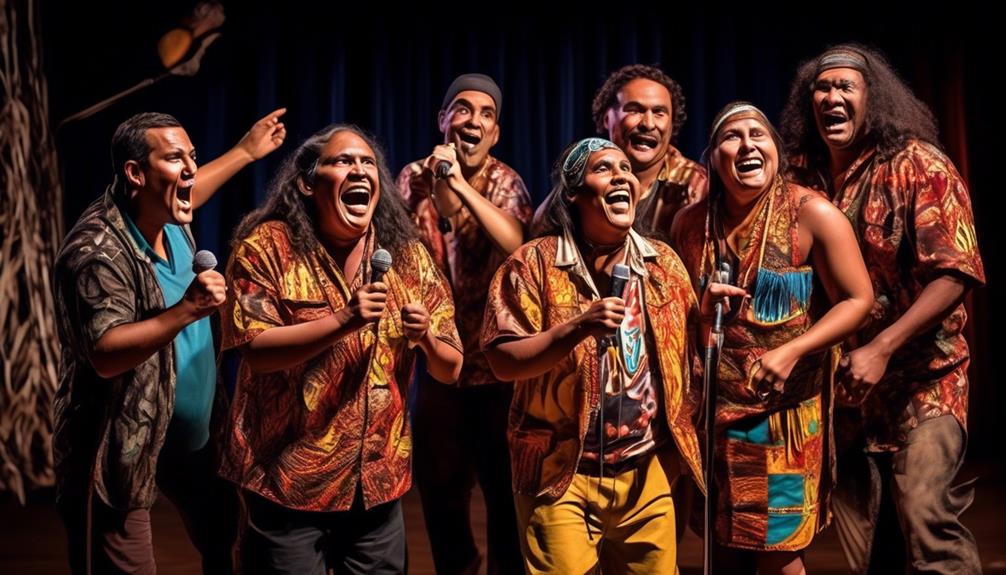
Prepare to be captivated by the uproarious and dynamic performances delivered by the Indigenous comedians in the All-Star Lineup. The Indigenous humor showcased in this comedy extravaganza offers a fresh and insightful perspective, drawing from diverse experiences and cultural backgrounds. Each comedian brings their unique voice to the stage, creating a comedy showcase that's as enlightening as it's entertaining.
The Indigenous comedians' side-splitting performances provide a glimpse into their lived experiences, often using humor to address complex social issues with wit and intelligence. Their ability to infuse comedy with cultural insights and personal narratives adds a layer of depth to the laughter, leaving the audience both entertained and enlightened.
These performances not only showcase the incredible talent of the comedians but also serve as a celebration of Indigenous culture and resilience. The audience is treated to a masterful display of comedic prowess, delivered with a mastery that can only come from lived experiences and innate understanding.
The All-Star Lineup presents an opportunity to engage with Indigenous humor and diverse perspectives, offering a comedic experience that's as thought-provoking as it's hilarious.
Cultural Observations
Captivating the audience with their side-splitting performances, the Indigenous comedians offer cultural observations that provide a fresh and insightful perspective, drawing from diverse experiences and cultural backgrounds. When it comes to cross cultural humor, the Aboriginal Comedy Allstars excel in weaving together a tapestry of relatable and thought-provoking content.
Here's a glimpse into the cultural observations that make their performances so impactful:
- Shared Experiences: Through their humor, the comedians skillfully highlight shared experiences that transcend cultural boundaries, fostering a sense of commonality and understanding among diverse audiences.
- Tradition and Modernity: The comedians adeptly navigate the delicate balance between traditional Indigenous values and the complexities of modern society, shedding light on the humor found in this intersection.
- Challenging Stereotypes: With grace and wit, the Allstars challenge stereotypes and misconceptions, offering a powerful and often humorous corrective lens through which to view Indigenous perspectives.
- Cultural Nuances: Delving into the nuances of Indigenous cultures, the comedians provide a rare opportunity for audiences to gain a deeper understanding and appreciation of the rich tapestry of Indigenous traditions and customs.
The cultural observations presented by the Aboriginal Comedy Allstars are a testament to the power of humor in fostering cross cultural understanding and appreciation for Indigenous perspectives.
Hilarious Storytelling

Immerse yourself in the world of uproarious tales and clever anecdotes as the Aboriginal Comedy Allstars weave together a tapestry of hilarious storytelling, captivating audiences with their wit and charm. Indigenous humor, deeply rooted in cultural traditions, is brought to life through the art of storytelling. The Allstars masterfully blend their comedic timing with storytelling techniques, creating an immersive experience that resonates with audiences on a profound level.
Drawing from their rich comedic traditions, the Allstars infuse their storytelling with a unique blend of wit, satire, and cultural insight. Their ability to craft narratives that aren't only side-splittingly funny but also deeply meaningful showcases their mastery of storytelling as a comedic art form.
The Allstars' storytelling techniques are multifaceted, seamlessly interweaving humor with insightful commentary on contemporary issues and age-old wisdom. Their comedic timing is impeccable, effortlessly delivering punchlines and weaving narratives that leave audiences in stitches. Through their storytelling prowess, the Allstars transcend mere comedy, offering a profound exploration of indigenous culture and identity, all while keeping the audience in fits of laughter.
Unforgettable Laughter
The Allstars' mastery of storytelling not only leaves audiences in stitches but also ensures that their performances create an atmosphere of unforgettable laughter, deeply rooted in their indigenous cultural traditions. When they take the stage, be prepared for an evening filled with laughter therapy and comedic excellence. Here's why their performances are so unforgettable:
- Cultural Insights: The Allstars infuse their comedy with deep cultural insights, offering a unique perspective that resonates with audiences on a profound level.
- Authentic Connection: Their ability to connect with the audience on a personal level, sharing experiences and anecdotes that invite laughter and reflection, creates an unforgettable bond.
- Joyful Celebration: Each performance feels like a joyful celebration of life, as they weave laughter into stories that celebrate the resilience and humor found in indigenous cultures.
- Universal Appeal: While rooted in indigenous traditions, the Allstars' humor transcends cultural boundaries, uniting audiences in a shared experience of laughter and joy.
Their comedic excellence not only entertains but also uplifts, leaving an indelible mark on anyone fortunate enough to witness their unforgettable performances.
Frequently Asked Questions
Are There Any Age Restrictions for Attending the Aboriginal Comedy Allstars Show?
You can attend the Aboriginal Comedy Allstars show if you meet the age restrictions. Ticket availability may vary, so it's best to check with the venue or the event organizers.
Keep in mind that age restrictions are in place to ensure a comfortable and enjoyable experience for all attendees. If you have any concerns about age requirements, reaching out to the event organizers directly can provide you with the most accurate information.
Can Audience Members Interact With the Comedians During the Performances?
During the performances, audience members can have an interactive experience with the comedians. Comedian audience interaction is a key part of the show, allowing for a lively and engaging atmosphere.
It's a chance to connect with the performers and be part of the comedic experience. The comedians welcome and encourage audience participation, making for a fun and inclusive show where everyone can join in on the laughter.
Is There Any Merchandise Available for Purchase at the Show?
Yes, at the show, there's merchandise available for purchase. Show souvenirs, such as t-shirts, hats, and DVDs, are usually offered for sale in the lobby before and after the performance.
It's a great way to support the comedians and take home a memento of the show. Be sure to check out the selection and pick up something to remember the experience by.
Are There Any Special Events or Meet-And-Greet Opportunities With the Comedians?
Discover delightful opportunities for fan engagement with the comedic maestros!
Comedy workshops captivate with wit and wisdom. Immerse yourself in the world of comedy and gain insight from the masters themselves. Sharpen your skills and revel in the camaraderie of like-minded enthusiasts.
Autograph sessions offer cherished mementos. VIP experiences provide exclusive access to mingle with the stars. These special events promise an unforgettable experience for comedy connoisseurs.
What Is the Seating Arrangement Like for the Show?
When you attend the show, the seating arrangement is designed to ensure everyone has a good view of the stage.
Audience participation is encouraged, and there are opportunities for interactive moments with the comedians.
The seating is arranged to create a welcoming and inclusive atmosphere, allowing for a truly engaging experience.
You'll find yourself in a comfortable setting, ready to enjoy the humor and connect with the performers.
Conclusion
So, if you want to experience a night of laughter that will shake your ribs and leave you gasping for air, the Aboriginal Comedy Allstars is the place to be.
Their performances are like a burst of colorful fireworks lighting up the night sky, leaving an imprint on your memory that will last a lifetime.
Don't miss out on the chance to be a part of this unforgettable cultural experience.
Talise is a talented writer and an expert in her field. Her unique perspective and insights enrich our content with depth and authenticity. With a wealth of knowledge and a strong connection to the subjects she writes about, Talise crafts engaging and informative articles that resonate with our readers. Her dedication to bringing Indigenous culture and wisdom to light is truly commendable.
-
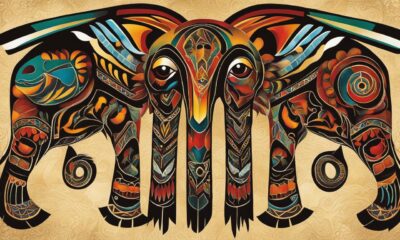
 Culture6 months ago
Culture6 months agoUnderstanding Aboriginal Totem Significance
-

 Torres Strait Islanders5 months ago
Torres Strait Islanders5 months agoJourney to Wellness: Indigenous Health Product Guide
-
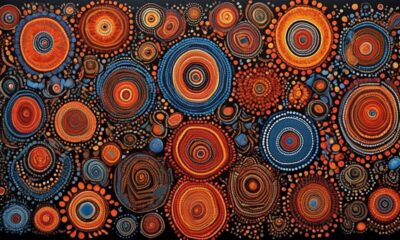
 Aboriginal5 months ago
Aboriginal5 months agoReadback Aboriginal Art
-
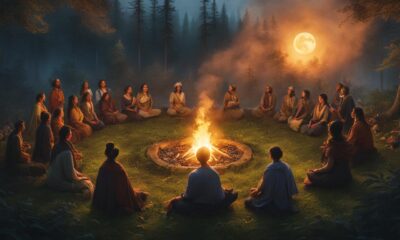
 Torres Strait Islanders5 months ago
Torres Strait Islanders5 months agoSacred Healing: Discovering Indigenous Health Secrets
-
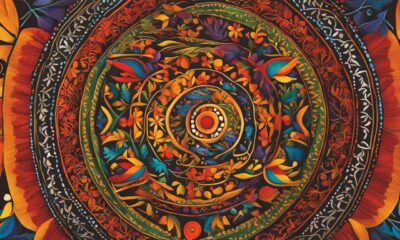
 Torres Strait Islanders5 months ago
Torres Strait Islanders5 months agoCultural Vitality: Indigenous Health Tips
-

 Torres Strait Islanders5 months ago
Torres Strait Islanders5 months agoHolistic Health: Indigenous Wellness Explored
-

 Torres Strait Islanders5 months ago
Torres Strait Islanders5 months agoEmbrace Indigenous Wisdom: Top Well-Being Products
-

 Torres Strait Islanders5 months ago
Torres Strait Islanders5 months agoNature’s Wisdom: Indigenous Well-Being Remedies




























